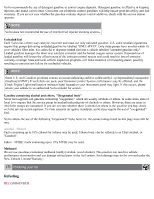2007 Volvo S80 Owner's Manual - Page 166
2007 Volvo S80 Manual
Page 166 highlights
2007 VOLVO S80 168 05 During your trip Driving recommendations 170 Refueling 174 Loading 179 Towing a trailer 182 Emergency towing 185 169 05 During your trip 170 05 During your trip Driving recommendations General information Economical driving conserves natural resources Better driving economy may be obtained by thinking ahead, avoiding rapid starts and stops and adjusting the speed of your vehicle to immediate traffic conditions. Observe the following rules: Bring the engine to normal operating temperature as soon as possible by driving with a light foot on the accelerator pedal for the first few minutes of operation. A cold engine uses more fuel and is subject to increased wear. Whenever possible, avoid using the vehicle for driving short distances. This does not allow the engine to reach normal operating temperature. Drive carefully and avoid rapid acceleration and hard braking. Use the transmission's (D)rive position as often as possible and avoid using kickdown. Do not exceed posted speed limits. Avoid carrying unnecessary items (extra load) in the vehicle. Maintain correct tire pressure. Check tire pressure regularly (when tires are cold). Remove snow tires when threat of snow or ice has ended. Note that roof racks, ski racks, etc, increase air resistance and also fuel consumption.
















